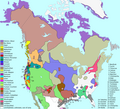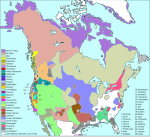File:Langs N.Amer.png
Appearance

Size of this preview: 661 × 600 pixels. Other resolutions: 265 × 240 pixels | 529 × 480 pixels | 847 × 768 pixels | 1,129 × 1,024 pixels | 1,290 × 1,170 pixels.
Original file (1,290 × 1,170 pixels, file size: 599 KB, MIME type: image/png)
| This is a featured picture, which means that members of the community have identified it as one of the finest images on the English Wikipedia, adding significantly to its accompanying article. If you have a different image of similar quality, be sure to upload it using the proper free license tag, add it to a relevant article, and nominate it. |
| This image was selected as picture of the day on the English Wikipedia for April 1, 2006. |
File history
Click on a date/time to view the file as it appeared at that time.
| Date/Time | Thumbnail | Dimensions | User | Comment | |
|---|---|---|---|---|---|
| current | 17:28, 20 July 2019 |  | 1,290 × 1,170 (599 KB) | Denniss | Reverted to version as of 21:52, 1 March 2009 (UTC) |
| 16:54, 13 July 2019 |  | 1,290 × 1,170 (840 KB) | Thylacinus cynocephalus | Having colonial borders on an indigenous language map is offensive | |
| 21:52, 1 March 2009 |  | 1,290 × 1,170 (599 KB) | Malus Catulus | optipng, pngout | |
| 14:31, 22 December 2006 |  | 1,290 × 1,170 (668 KB) | Mahahahaneapneap | pngcrushed | |
| 00:43, 11 November 2006 |  | 1,290 × 1,170 (916 KB) | Ish ishwar | update | |
| 04:55, 1 April 2006 |  | 1,296 × 1,176 (678 KB) | Locke Cole | smaller file (pngout /f0 Langs_N.Amer.png /b4096) / Change: -315546 bytes ( 68% of original) | |
| 04:01, 7 January 2006 |  | 1,296 × 1,176 (986 KB) | Ish ishwar | adai,chimariko = unclassified; adjust uto-aztec, salinan, southern athabasc., muskogean; + Isla Ángel de la Guarda, Isla del Tiburón, Lake Okeechobee | |
| 21:24, 9 December 2005 |  | 1,318 × 1,195 (714 KB) | Ish ishwar | checker grid pattern to Chumash | |
| 06:12, 6 December 2005 |  | 1,318 × 1,195 (714 KB) | Ish ishwar | forgot seri, fix fam key | |
| 01:21, 6 December 2005 |  | 1,318 × 1,195 (712 KB) | Ish ishwar | update |
File usage
The following 46 pages use this file:
- Caddo Lake State Park
- Canadian folklore
- Classification of the Indigenous languages of the Americas
- First Nations in Canada
- Former colonies and territories in Canada
- History of the Americas
- Indigenous peoples of the Americas
- Linguistics and the Book of Mormon
- List of language families
- Lower Rio Grande Valley
- Native Americans in the United States
- North America
- Pacific Northwest languages
- Talk:Early Slavs/Archive 1
- Talk:Indigenous peoples of the Americas/Archive 1
- Talk:New World
- User:Carcharoth/Arctic articles
- User:Cyde/Featured pictures
- User:Falcaorib/Canada, United States and Mexico
- User:Ish ishwar
- User:Jmjosh90/sandbox/Archives/2022/March
- User:Joelton Ivson/Gather lists/24453 – Indígenas nas Américas
- User:North8000
- User talk:Ish ishwar/2005talkpage
- User talk:Wapcaplet/Archive 3
- Wikipedia:Featured picture candidates/December-2005
- Wikipedia:Featured picture candidates/Indigenous language families north of Mexico
- Wikipedia:Featured pictures/Diagrams, drawings, and maps/Maps
- Wikipedia:Featured pictures thumbs/03
- Wikipedia:POTD/April 1, 2006
- Wikipedia:POTD column/April 1, 2006
- Wikipedia:POTD row/April 1, 2006
- Wikipedia:Picture of the day/April 1, 2006
- Wikipedia:Picture of the day/April 2006
- Wikipedia:Reference desk/Archives/Humanities/2012 July 4
- Wikipedia:Reference desk/Archives/Language/2010 March 2
- Wikipedia:Today's second feature/April 1, 2006
- Wikipedia:Wikipedia Signpost/2005-12-26/Features and admins
- Wikipedia:Wikipedia Signpost/2013-06-05/News and notes
- Wikipedia:Wikipedia Signpost/Single/2005-12-26
- Wikipedia:Wikipedia Signpost/Single/2013-06-05
- Portal:Indigenous peoples of the Americas
- Portal:Maps/Selected picture
- Portal:Maps/Selected picture/20
- Portal:North America/Selected picture
- Portal:North America/Selected picture/5
Global file usage
The following other wikis use this file:
- Usage on azb.wikipedia.org
- Usage on ca.wikipedia.org
- Usage on en.wikibooks.org
- Usage on en.wikiversity.org
- Usage on eo.wikipedia.org
- Usage on es.wikipedia.org
- Usage on eu.wikipedia.org
- Usage on fa.wikipedia.org
- Usage on fi.wikipedia.org
- Usage on fi.wikibooks.org
- Usage on fr.wikipedia.org
- Usage on fy.wikipedia.org
- Usage on gl.wikipedia.org
- Usage on he.wikipedia.org
- Usage on hr.wikipedia.org
- Usage on hsb.wikipedia.org
- Usage on hu.wikipedia.org
- Usage on hy.wikipedia.org
- Usage on ia.wikipedia.org
- Usage on id.wikipedia.org
- Usage on ilo.wikipedia.org
- Usage on incubator.wikimedia.org
View more global usage of this file.


